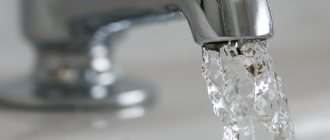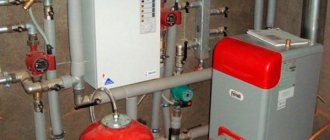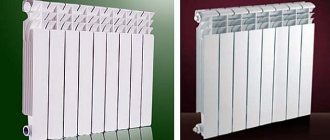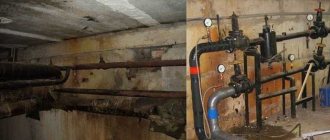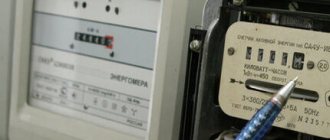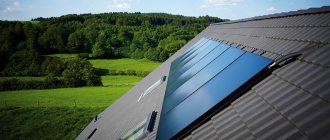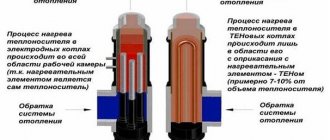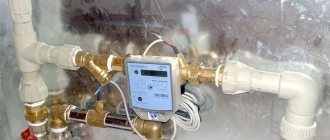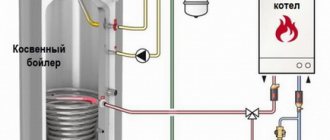Swimming pool calculations
The calculation of heating water in a pool consists of calculating the parameters of the electric heater and the volume that needs to be heated. The table shows the approximate time in hours during which the temperature rises from 10 °C to 28 °C. In this case, the area of the water “mirror”, the ambient temperature, and the degree of openness/closeness of the pool location play a significant role in the final calculations.
Source
Storage water heaters (boilers)
Without physical and mathematical formulas, a household calculation is described as follows: in 1 hour, 1 kW heats 860 liters per 1 K. To more accurately determine the heating time, power characteristics, and volume, a universal formula is used, from which the remaining results are then derived:
This formula consists of several and reflects a number of parameters, taking into account the heat loss factor. (With low power characteristics and large volume, this factor becomes more significant, however, in household heaters this accounting value is often neglected):
Nfull – power characteristics of the heating element,
Qc – heat loss of the water heating tank.
- c= Q/m*(tк-tн)
- C – specific heat capacity,
- Q – amount of heat,
- m – mass in kilograms (or volume in liters),
- tк and tн (in °С) – final and initial temperatures.
- N=Q/t
- N – heating power characteristics.
- t—heating time in seconds.
- N = Nfull - (1000/24)*Qc
General data required for calculations
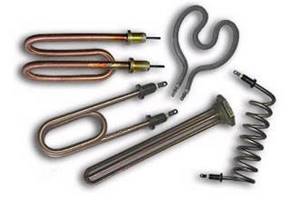
Therefore, devices for this parameter are selected in accordance with the tasks, the required volume and the allowable waiting time. So, for example, heating 15 liters to 60°C with a 1.5 kW heater will take about an hour and a half. However, for large volumes (for example, to fill a 100-liter bath) with a reasonable waiting time (up to 3 hours), a device 3 kW more powerful will be needed to bring the liquid to a comfortable temperature. To fully calculate the design power, it is necessary to take into account a number of parameters:

- Working resource of a household electrical network. The problem of “knocking out traffic jams” is especially pressing in secondary housing stock. Some residents, having encountered this problem (for example, when installing electric radiators), solved the problem by adding a separate cable or strengthening the wiring. However, a more universal recipe is to buy a water heater with medium or low energy consumption (usually storage-type devices). The difference between the number of kilowatts of the household electrical network and the total power of all household electrical appliances will give the value of the optimal power of the water heater that you need to strive for.
- The ratio of the power of the heating element (heating element) and the volume of the tank. A parameter that is more important for storage-type devices, in which water is consumed gradually, and the rate of its cooling becomes critical. To prevent a 1-kilowatt water heater from being purchased with 100-liter tanks, manufacturers provide an indicative table, where a 1-kilowatt device is designed for 15 liters, 1.5 kW – for 50, 2 kW – for 50-100, and 5 kW – for 200 - liter tank.
- Water flow rate per minute. The parameter is more important for instantaneous water heaters. In everyday life, the power indicators of such a heating device (taking into account the maximum resource consumption) are calculated by multiplying by two the number of liters of fuel consumption per minute. That is, if an average of 4 l/min is spent on running dishes, then the heating element should be 8 kW. If 8 l/min is consumed when taking a shower, then a 16-kilowatt heating element is needed. The calculations are complicated by the fact that the apartment uses 2 (and sometimes 3) water intake points at once. In this case, it is recommended to multiply the resulting value by one and a half times in calculations.
Reference
This calculator will calculate how much money, electricity and time is spent heating water.
You don't need any formulas or coefficients: just enter your data and get the answer. To calculate the consumed electricity, you must indicate the temperature of cold and hot water, as well as its volume (mass). You can indicate the efficiency of the heating device if you know it. If you set the efficiency to 100%, the calculation will show only the useful power spent on heating water. When indicating the real efficiency, the calculation will give the total power consumed from the network.
To calculate the full cost of heating water, you need to set your electricity tariff in rubles.
To estimate how long it takes to heat up, indicate the power of the electrical appliance you use to heat water, in kilowatts (kW). The power is often indicated on the body of the device, as well as in its instruction manual or passport.
Saving should be economical!
Hot water supply in a house, apartment or cottage is not a luxury, but a minimum necessary comfort. Regardless of whether you live there permanently or just come for weekends during the warm season. Hot water is needed both for washing dishes and for washing after a hard day or simply refreshing yourself in the shower during the summer heat. In general, hot water is, first of all, good hygiene, and cleanliness, as we know, is the key to health.
Many people know firsthand about the inconveniences that follow accidents on heating mains. Much has been said about the “inflated” tariffs for centralized hot water supply, which include all the costs of maintaining it in working condition. And how many words have been said about public utilities that cut off hot water to everyone for a month each year due to preventive maintenance?!
One can abstractly talk about the positive changes in everyday life that occur with the start of using a household water heater and real financial savings for a long time and to no avail. Therefore, it is better to discuss this using real examples and figures.
Let's look at the cost of consumed water in three options:
- When connected to a centralized hot water supply;
- When installing a storage water heater;
- When installing an AQUATERM instant water heating tap.
